I tried to milk a cow. Here’s how it went.
A few months ago, while I was squeezing a cheesecloth filled with pulped nuts to make almond milk, I realized that I had yet to milk a cow. It took the gush of almond juice between my fingers for me to realize that this was the closest to milking a “teat” that I had ever gotten.
What kind of wannabe homesteader was I, anyway?
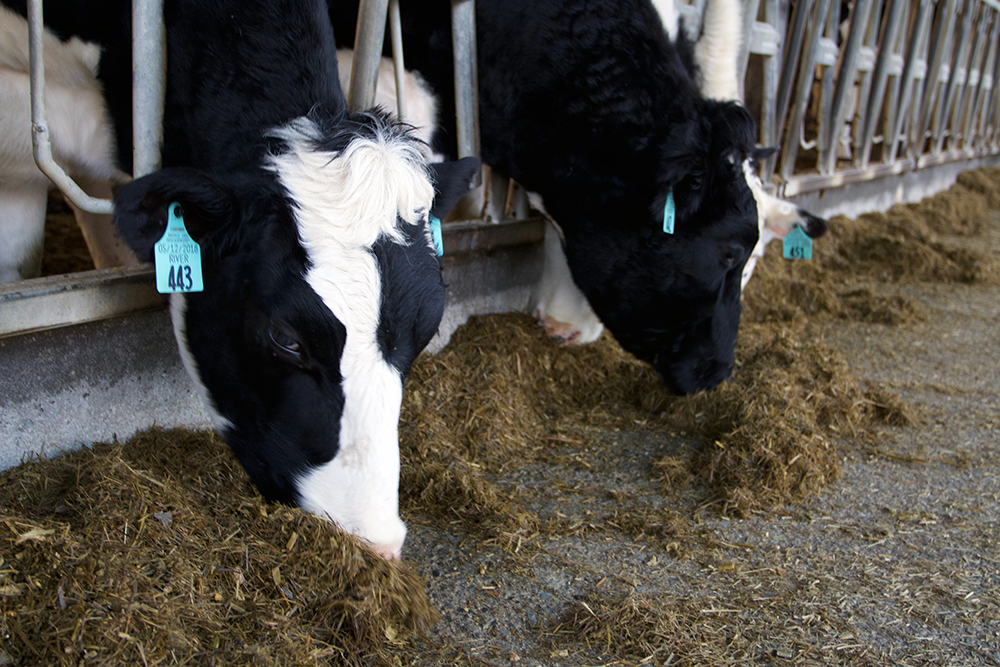
There are several reasons for my lack of milking experience. One is access. Cows (and most other livestock, for that matter) aren’t allowed in most areas of Bangor, so it is harder for me to ask a neighbor to help with their daily milking duties than it is for me to, say, buy a bag of almonds to make almond milk.
Another reason is more personal and slightly embarrassing: I love animals, but they make me skittish. I grew up in the suburbs and I never had pets (my boyfriend’s rabbit, Hector, is a recent exception). I am skeptical at the idea of forming a symbiotic working relationship with an animal, especially one with significant tonnage and a powerful kick. Even when I watch cows peacefully grazing in a pasture, the way they whip their heads and stomp their hooves remind me that, if they were to coalesce and stampede in my direction, I’d wind up looking a lot like a cow pie.
The thought of crouching under one of these titanic quadrupeds to yank at their most sensitive parts was more than a little unsettling to me. If I was going to learn how to milk a cow, I was going to need a patient, animal-loving expert to help me do so.
Every so often, social media brings us moments of serendipity. When the Maine Animal Club’s Milk-a-Cow event popped across my Facebook feed, it felt like kismet. The club of students at the University of Maine has hosted the event for the past three years at the university’s farm, the J. Franklin Witter Teaching & Research Center.
“We thought it was a good idea because it’s a good way to promote farming and dairy farming to the public,” said Hadley Moore, president of the Maine Animal Club. “Most people may not have family members that own a farm [but] it’s important for people to understand what goes into the care of animals.”
Moore said the event, which serves as a fundraiser for the club to travel to events like out-of-state animal science competitions, livestock judgings and quiz bowls, really took off last year, ballooning from a couple dozen attendees the previous year to over a hundred. More importantly, Milk-a-Cow is popular with families and kids, which means the student instructors would be ready to handle a jittery, uncoordinated novice milker like me.
Learning to try
Hand milking always seemed arcane to me. Many dairies rely on milking machines, which have four rubber-lined cups that pump milk from a cow’s teats into a tank, because they are exponentially more efficient. According to the American Dairy Association, milking machines can milk a cow in five minutes. Before milking machines were popularized, farmers could only milk about six cows per hour.
Milking machines present a double-edged sword for dairies, though. While the number of dairy farms in the United States has decreased dramatically in the past few decades, the overall production of milk has increased, in part thanks to mechanization. The supercharged production per cow has led to an oversupply in the market while demand continues to fall, driving milk prices well below the cost of production.
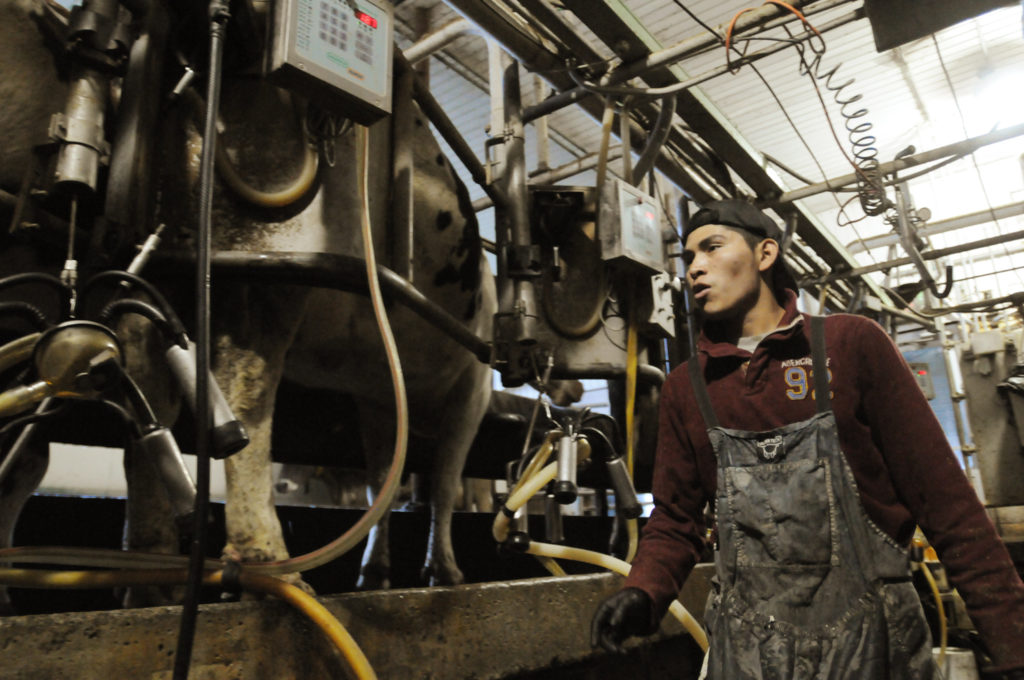
Impact on the dairy industry aside, the misconception that hand milking is a primitive skill really showed how little I knew about the process. Besides the fact that small-scale farmers may not be able to justify buying expensive milking machines when they are only raising a few cows on their property, even machine milkers need to know how to go through hand-milking motions.
When I arrived at Milk-a-Cow, David Marcinkowski, faculty adviser to the Maine Animal Club and extension dairy specialist at the University of Maine Cooperative Extension, explained that farmers still need to hand milk their cows even if they are headed for milking machines. The process, known as “stripping,” tests the milk for clots or other abnormalities and helps kick off the physiological elements of milking.
“You have to hand milk first,” he said. “Once you do that, it stimulates oxytocin hormone release and then they will let down the milk to the [machine] chamber.”
Clearly, I had a lot to learn. Luckily, Madison Philbrick, a member of the Maine Animal Club and milking instructor extraordinaire, was there to help.
First, she introduced me to Blue, a Holstein dairy cow that is part of the university’s herd. Blue is outfitted with a rumen fistula, a permanent opening in her side covered with a thick plastic cap so that researchers can easily remove feed samples from her stomach to study. Madison explained that the fistula does not hurt Blue or impact her health and longevity. The direct opening to her stomach does make her a bit smellier than her fellow cows, but I didn’t mind (I’m smellier than a lot of my friends, too).
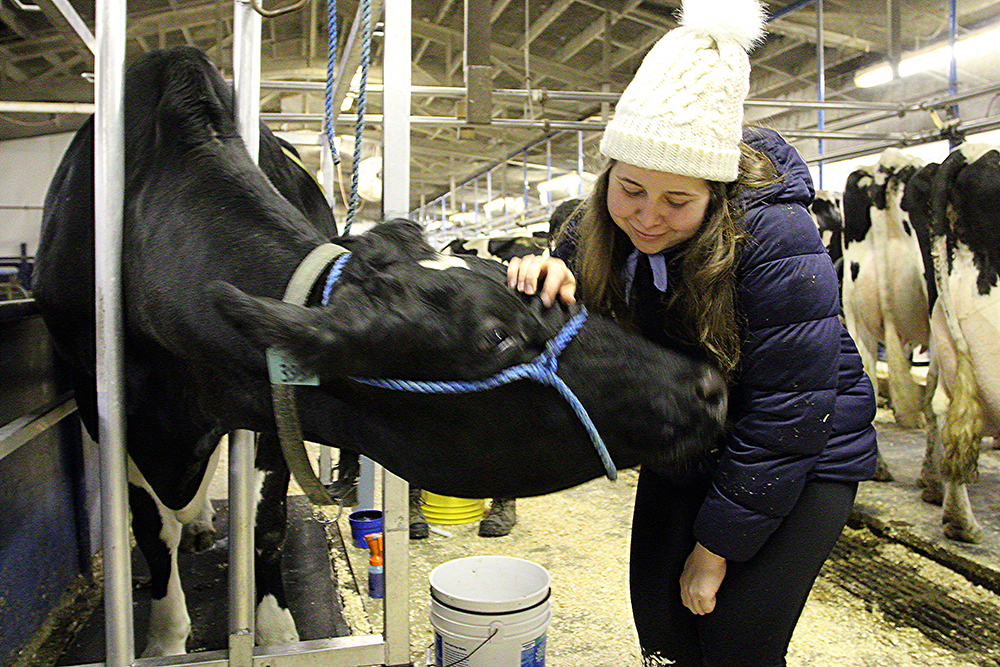
Sanitation is essential for milking, especially for events like Milk-a-Cow. Madison gave me a pair of gloves and demonstrated how to dip the teats with a bright blue iodine solution before and after milking. She squeezed the bottle and quickly doused each of Blue’s teats in the frothy blue liquid.
Then, she showed me how to “strip” and milk the teats. The hand motion was challenging, like rubbing your tummy and patting your head at the same time, but that technique is important. Madison said that poor teat handling can lead to blockages that make the cow sick.
After stripping Blue and wiping her down, Madison milked her a little bit more and then doused her with another round of dip. She handed the bottle to me and made space for me to crouch down besides her. Ready or not, it was time for me to milk a cow.
A trying experience
I was predictably nervous about milking Blue. I was only somewhat confident in my hand technique. While Blue seemed to be a perfectly agreeable bovine, I’m sure she would not take kindly to blockages and bumbling hands around her udder.
In all my nerves, I fumbled with the dip, not squeezing nearly enough to fully douse the teat. With Madison’s help, though, I was able to get full coverage to prepare the teats for stripping.
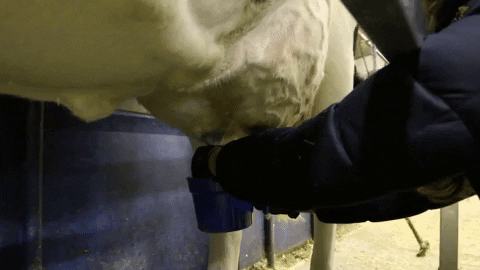
Remarkably, I was a natural. Once my fingers were around the teat (which is surprisingly warm and somewhat unsettlingly pliant), the hand motion was more intuitive than it initially seemed. I checked Blue’s milk (and showed it to Madison, because what do I know, really) to confirm that there were no suspicious chunks or colors before moving ahead.
After a few minutes of milking, Blue gave an indignant stomp. I balked — had she changed her mind about our bonding over body odor? Was I about to be kicked? Madison patted Blue’s haunch and explained that cows tend to “dance” impatiently when they are being milked, but not to worry. Patience, calm and consistency is essential; the cow will pick up the tone you set.
After milking for a few minutes, it was time to let another Milk-a-Cow attendee have a turn. My fingers ached, and the children were growing impatient. I was surprised how little milk my efforts yielded. Madison said it would take hours to milk the nearly thirty cows in the herd at Witter Farm, and they need to be milked regularly for their health. Though the dairy industry’s woes are legitimate, I understand more intimately the need for mechanization, especially for large herds.
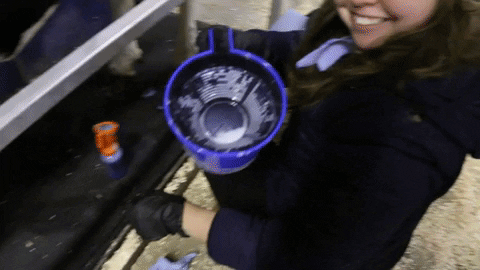
I cleaned Blue up and asked Madison how I did. Maybe she was being kind, but she said I did great, even compared to some of the students she trained this fall. Perhaps there is a homesteader in me yet.
My tried-and-true takeaways
First of all, I highly recommend events like Milk-a-Cow at Witter Farm or whatever hands-on events may be held at your local cooperative extension. Whether you want your city-dwelling children to have exposure to livestock or need your own farm fix, research and demonstration farms provide a wonderful opportunity to enjoy animals while learning more about the agricultural systems we engage with every day. Added bonus: adorable calves.
Since I have milked a cow, my uneasiness around the enormous ungulates has eased. Cows are like big dogs. I can’t even count how many cow kisses and gentle nudges I got just walking through the barn. Aside from the occasional tap dancing, cows are generally patient with tedious tasks like milking if you are calm and gentle with them.
I think everyone should milk a cow, if just to learn a little bit more about where milk comes from, and to get an appreciation for how much work it takes to produce it. Milking a cow should always be done with care, but if you pay attention to the hand motion and get into a rhythm, it is not an arcane or inscrutable skill to master — or, at least, pull off without embarrassing yourself in front of a bunch of children and farm-savvy college students.

Hello Sam 🙂 l came across an ad for this website titled “Sam Tries Things” & was/am intrigued. My 1st thot was to share it with my niece whom you appear to share age with as well as personality, but decided to “check it out” first… Wow! I am really Happy that l did & have already saved your website to my homescreen 🙂 l REALLLY enjoyed your 1st cow milking experience & how well you put forth YOUR experience, VERY Nice!! I spent time living on a farm in my youth & now do not, (like you; l now drink Almond Milk), but l now have Amish friends who still do & milking is commonplace everyday. I still WILL be sharing this with my niece but now as well as returning to it often myself, l will be sharing with the REST of my 32 (yep, 32 🙂 nieces & nephews with my encouragement & recommendations! ? Keep it up & I’ll keep sharing…
Sincerely, John